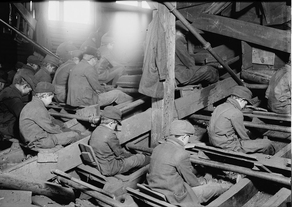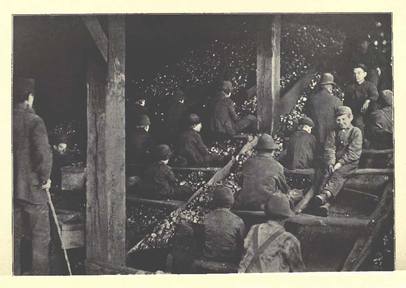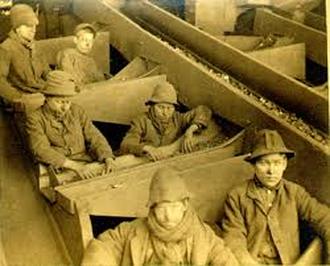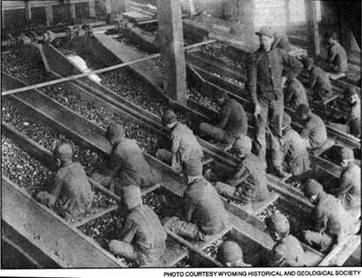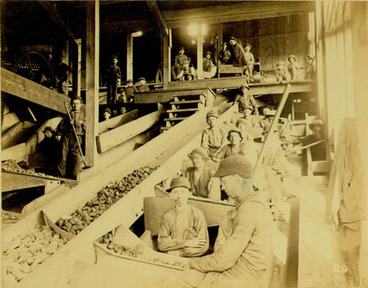|
A breaker boy was a young coal mining worker whose job was
to detach impurities from coal. They would separate slate, rocks, and other
debris from coal by hand. These boys
were usually between the ages of 8 to 12, but sometimes were as young as 5 or
6. In 1885, Pennsylvania State law required a coal breaker to be at least 12
years old. (2) (3) (5)
Unfortunately this law was poorly enforced and many employers forged proof of age documents since they couldn’t care less that these boys were under age. Also, many parents often presented fake birth certificates with altered dates so their children could work. For a 25 cent fee, the parent would have this fake certificate notarized. They needed their children to work to help supplement the family income. Many of these children came from immigrant families and were subject to extreme poverty conditions. The children would work for 40 to 50 cents a day, which was a fraction of what the adults earned. (2) (3) |
The breaker boys would go to work
in the morning when it was still dark and would come home just in time to see
the sun go down. These children were forced into the labor force causing them
to have to drop out of school. Some of them would attend night school, but
since they were so worn out from working all day the results were
unimpressive. A portion of these boys
never stepped foot inside of a school and without a chance to learn, many of
these kids couldn’t read or write. All
the breaker boys knew was the difference between coal and slate. (1) (5) (6)
|
The coal breaking occupation was very dangerous and difficult for these young kids. The function of a coal breaker is to break coal into pieces and sort them into categories of nearly uniform size. The second function is to remove as many impurities as economically desirable and feasible. Then the coal was graded based on the percent of impurities remaining. The breaker boys would work a labor intensive 10 hours a day, 6 days a week. (1) (2) (4)
They would sit on wooden benches perched over chutes and conveyor belts. Some of the boys would work on top of the chutes. These boys would stop the coal by pushing their boots into the stream of coal flowing beneath them and try to pick out the impurities. Others would divert the coal into a horizontal chute where they sat to pick out the unwanted material before the coal would go to the clean coal bins. (2) (4) |
The breaker boys were forced to
work without gloves so they could better handle slick materials and for better
agility. The slate they were trying to remove was very sharp, so the boys would
often leave with their fingers cut and bleeding. If they were caught wearing
gloves, the boss would beat them.
Sometimes the breaker boys would have their fingers amputated by the fast moving belts. New breaker boys would develop blood finger tips, which could be described as red fingertips. These new workers would develop this condition because of their soft finger tips scraping over the top of coal and rock. The condition would persist until their fingers toughened enough that they wouldn’t bleed anymore. The only thing that would help cure the problem was to urinate on the finger tips to toughen them up. (2) (3) (5)
Sometimes the breaker boys would have their fingers amputated by the fast moving belts. New breaker boys would develop blood finger tips, which could be described as red fingertips. These new workers would develop this condition because of their soft finger tips scraping over the top of coal and rock. The condition would persist until their fingers toughened enough that they wouldn’t bleed anymore. The only thing that would help cure the problem was to urinate on the finger tips to toughen them up. (2) (3) (5)
|
The boys would also suffer from a
skin condition called red tips. This was caused by sulfuric acid created by the
coal being washed to remove impurities. Prolonged contact with the sulfuric
acid would burn the fingers and hands of the boys. There were also many other
hazards that the breaker boys had to deal with. (3)
Besides cutting or losing their fingers, some boys lost their feet, hands, arms, or legs as they moved among the machinery if they became caught under conveyor belts or in gears. Production never stopped, even when boys were crushed to death. Only at the end of the work day were their young bodies retrieved from the gears of the machinery by their supervisors. Other breaker boys were caught in the rush of coal in the chute, causing them to be crushed or smothered to death. Occasionally a boy would fall into the coal crusher and be ground into pieces. (2) (3) (5) |
The work conditions for breaker
boys were hazardous and depressing to say the least. Their work was done inside
a large noisy room. They worked in this hole all day long trying to keep warm
in the winter and cool in the summer. The breaker room had high walls where the
long iron chutes ran to the breaker floors. The floor of the breaker boy’s room
consisted of an inclined plane which had a constant stream of coal flowing into
it. (2) (5)
There were clouds of dust surrounding everything in the room, creating a black cloud like atmosphere. The dust was often so thick, that the boys couldn’t see their outstretched arms. To help the boys from inhaling the dust, they would cover their mouths with handkerchiefs. Also a lot of them would chew tobacco to help absorb the dust. It also took no time at all for them to become covered from head to toe in coal dust. This would lay the foundation for many of the breaker boys to suffer from asthma or other respiratory conditions. (5) (6)
There were clouds of dust surrounding everything in the room, creating a black cloud like atmosphere. The dust was often so thick, that the boys couldn’t see their outstretched arms. To help the boys from inhaling the dust, they would cover their mouths with handkerchiefs. Also a lot of them would chew tobacco to help absorb the dust. It also took no time at all for them to become covered from head to toe in coal dust. This would lay the foundation for many of the breaker boys to suffer from asthma or other respiratory conditions. (5) (6)
|
The breaker boys also would suffer
from hearing impairments due to the constant loud noise in the breaker rooms.
All day long, the breaker boys would be submitted to the loud grinding noise coming
from the machinery. Their young ears
would also be damaged by the noise of the large amounts of coal rushing down
the chutes. These young boys would stay
hunched over all day long picking at the coal without a chance to relax. By being
in this cramped position all day long, most of the young breakers boys became
deformed. Most of these boys looked like
a crooked backed old man. (2) (3)
The breaker boys’ boss was called a chute boss or breaker boss, and he was very unpopular with the young lads. If they did not do their job right he would smack them with a club or throw rocks at their fingers. If the boys thought they were being mistreated, they would retaliate by teasing or annoying the breaker boss. They would throw rocks at him while his back was turned or throw a board into the machinery to cause it to break down. Then they would run around will playing games. (5) |
Because of their feelings of
independence, breaker boys would often protest by forming strikes or joining trade
unions. They would participate in strikes, which would ultimately shut down all
operations. Employers would beat the
young workers until they grudgingly went back to work. And even the boy’s
father would often help the bosses because they were losing money. If these
boys were able to survive the breaker room, many of them would go on to work in
the depths of the mines where the work was even more dangerous. (2) (5)
|
The use of breaker boys diminished
later in the 1910’s, and by 1920 the use of breaker boys largely ended. This
happened for a couple reasons. First there were improvements in technology. But
the biggest reason for the decline was much stricter child labor laws. It took
congress a long time to pass a national law increasing the legal working age
and to improve work conditions. Even though the National Child Labor Committee
was formed in 1904, these children were still put in harm’s way for over
another decade. (2)
Everything changed when committee member and photographer, Lewis Hines, made public the photos he took of these children working in the mines and elsewhere. He used few words but extremely powerful images to help educate the American public. Once the photos were made public, the majority of the public demanded reform. There were numerous battles in the courtroom over the use of child labor. (2) (3) (6) |
The first child labor law passed in
1916, but was declared unconstitutional by the Supreme Court. Finally in 1938
the Fair Labor Statistics Act passed, and this law is the basis of other labor
reform laws still today. Children the ages of 14 and 15 can work, as long as it
doesn’t interfere with their schooling. Children under the age of 18 are
prohibited from working in a hazardous occupation. Part of the Industrial
Revolution was put on the backs of these young boys, and they paid the price
for it. But they should be thanked for their sacrifice. Because without their
sacrifice, our children today might not be as well off as they are. (2) (3)
References
[1] Schnapper, M. B. "Coal Mine Breaker Rooms." Welcome
to the Snohomish County Labor Council Web Site. N.p., n.d. Web. 6 Nov.
2014. <http://www.snolabor.org/pages/coal.htm>.
[2] Wikipedia contributors. "Breaker boy." Wikipedia, The Free Encyclopedia. Wikipedia, The Free Encyclopedia, 31 Jan. 2014. Web. 12 Nov. 2014.
[3] Wagner, Jennifer. "The History of Child Labor During the American Industrial Revolution." IHS Child Slave Labor. National Labor Committee, Oct. 2002. Web. 12 Nov. 2014. <http://ihscslnews.org/view_article.php?id=95>.
[4] Spargo, John. "No Rest for the Weary: Children in the Coal Mines." History Matters: The U.S. Survey Course on the Web. George Mason University, n.d. Web. 12 Nov. 2014. <http://historymatters.gmu.edu/d/5571/>.
[5] Bartoletti, Susan Campbell. Growing Up In Coal Country / Susan Campbell Bartoletti. n.p.: Boston : Houghton Mifflin Co., 1996., 1996. PILOT (Clarion University’s Library Catalog). Web. 15 Nov. 2014.
[6] Miller, Randall M., and William Pencak. Pennsylvania : A History Of The Commonwealth / Edited By Randall M. Miller And William Pencak. n.p.: University Park : Pennsylvania State University Press ; Harrisburg, Pa. : Pennsylvania Historical and Museum Commission, c2002., 2002. PILOT (Clarion University’s Library Catalog). Web. 15 Nov. 2014.
[2] Wikipedia contributors. "Breaker boy." Wikipedia, The Free Encyclopedia. Wikipedia, The Free Encyclopedia, 31 Jan. 2014. Web. 12 Nov. 2014.
[3] Wagner, Jennifer. "The History of Child Labor During the American Industrial Revolution." IHS Child Slave Labor. National Labor Committee, Oct. 2002. Web. 12 Nov. 2014. <http://ihscslnews.org/view_article.php?id=95>.
[4] Spargo, John. "No Rest for the Weary: Children in the Coal Mines." History Matters: The U.S. Survey Course on the Web. George Mason University, n.d. Web. 12 Nov. 2014. <http://historymatters.gmu.edu/d/5571/>.
[5] Bartoletti, Susan Campbell. Growing Up In Coal Country / Susan Campbell Bartoletti. n.p.: Boston : Houghton Mifflin Co., 1996., 1996. PILOT (Clarion University’s Library Catalog). Web. 15 Nov. 2014.
[6] Miller, Randall M., and William Pencak. Pennsylvania : A History Of The Commonwealth / Edited By Randall M. Miller And William Pencak. n.p.: University Park : Pennsylvania State University Press ; Harrisburg, Pa. : Pennsylvania Historical and Museum Commission, c2002., 2002. PILOT (Clarion University’s Library Catalog). Web. 15 Nov. 2014.
Image References
[1] “Breaker Boy”, Web. 22 Nov. 2014.
<http://upload.wikimedia.org/wikipedia/commons/9/97/Pennsylvania_breaker_boys_1911.jpg>.
[2] Breaker boy communications. Web. 27 Nov. 2014. <http://www.thebreakerboy.com/img/boys_services.jpg>.
[3] Bretz, George. Breaker boys at the Eagle Hill colliery near Pottsville, Pennsylvania. 1884. Web. 22 Nov. 2014.<http://upload.wikimedia.org/wikipedia/commons/0/0b/Breaker_boys,_Eagle_Hill_colliery,_eastern_PA_1.jpg>.
[4] "Breaker boys" at work in one of the Pittston, PA coal breakers. Wyoming Historical and Geological Society. Web. 22 Nov. 2014. <https://www.mca-marines.org/images/BLOG/3.breaker_boys.jpg>.
[5] Bertz, George. Breaker Boys, North Ashland Colliery. Cleveland, Ohio: Teaching & Learning Cleveland,. 1884. Web. 22 Nov. 2014.<http://childlaborlawsandbreakerboys.weebly.com/uploads/2/5/8/0/25805853/8635266_orig.jpg>.
[2] Breaker boy communications. Web. 27 Nov. 2014. <http://www.thebreakerboy.com/img/boys_services.jpg>.
[3] Bretz, George. Breaker boys at the Eagle Hill colliery near Pottsville, Pennsylvania. 1884. Web. 22 Nov. 2014.<http://upload.wikimedia.org/wikipedia/commons/0/0b/Breaker_boys,_Eagle_Hill_colliery,_eastern_PA_1.jpg>.
[4] "Breaker boys" at work in one of the Pittston, PA coal breakers. Wyoming Historical and Geological Society. Web. 22 Nov. 2014. <https://www.mca-marines.org/images/BLOG/3.breaker_boys.jpg>.
[5] Bertz, George. Breaker Boys, North Ashland Colliery. Cleveland, Ohio: Teaching & Learning Cleveland,. 1884. Web. 22 Nov. 2014.<http://childlaborlawsandbreakerboys.weebly.com/uploads/2/5/8/0/25805853/8635266_orig.jpg>.

